As the proliferation of the electric car infuses into the American landscape, the problems of scale are already presenting themselves into phase three, the mass production phase, proceeding step one: development and introduction, and step two: adoption phase. We’re leaving phase 2 going into phase or step 3, as the next few months going into next year will see a big proliferation of new models, even more so in 2020 and beyond. Once they got mass production ramped up at Tesla, they had a problem storing and transporting tens of thousands of newly assembled Model 3’s piling up in once empty lots in no-where locales, en masse, to growing impatiently waiting waitlisted customers. There’s currently a nationwide flood of late model used EV’s coming off leases to create a massive EV inventory glut in the wake of a booming used car sales market.
Substantial deals are to be made on Leafs, by the way. In California where the state is trying to lead other states as an example of green technology, the Federal Administration leads with coal, oil sands, offshore and once protected land drilling, and gas pipelines. All this, while another problem of scale presents itself in the EV Revolution: too many electric cars with single occupants in the HOV lanes.
I say it’s wonderful we have these problems with electric cars! In the land where EV’s of many kinds have ruled for four decades, this phenomenon probably won’t happen in other places in the states for a while. But like everything else California does, it does give us a glimpse of the problems the rest of us will face with electric cars down into the future. And because of this, the rest of us will be paying attention to California to see how they resolve it: How to narrow the criteria of who gets to drive a one person occupied EV car at any time of the day on a California HOV lane?
The HOV Issue:
- Jan 1, 2019 220,000 CA EV owners will lose EV exemption in CA HOV lanes with more motorists to come, and people are angry.
- The CA state Legislature passed a measure last year that significantly limits the number of people eligible for HOV decals.
- The criteria is lopsided and doesn’t make sense.
- Criteria: Income and 2017 is the cut-off, regardless of vehicle classification:
- As of New Year’s Day, drivers who received their clean-air stickers before 2017 will have to buy new vehicles to qualify for the program, or
- Purchase used cars that have never had a decal but would have qualified for one in 2017 or 2018.
- Some who earn above a certain income amount won’t be eligible for the stickers at all, even though some of the accessways are free.
- Part of the backlash is that carpool lanes are also being shared by large numbers of solo gas driven violators who illegally use the lanes to cut down on commute time.
- The California Highway Patrol (CHP) is too small of a police force to have a dedicated HOV task force.
- To keep federal subsidies, the lane must maintain an average speed 45 mph, otherwise the lane might violate federal guidelines.
California’s Solution (thus far):
Under these rules, a not often but still a smog producing thus low emissions gasoline motor equipped PHEV hybrid, like a 2019 Chevy Volt that after its paltry low range goes back to gasoline to pollute the air again, takes precedent over a full electric BEV if you purchased a 2016 Tesla Model S new, that is a zero emissions vehicle, but a bit older now. Huh? Some say that’s not fair, and of course it’s not: that defeats the purpose of why electric cars are here. It’s supposed to be about ZERO EMISSIONS, not just LOW EMISSIONS.
The PHEV Issue:
We forget that PHEV’s are transition vehicles. The legendary Bob Lutz, “the Car Guy” and retired Vice-Chair of General Motors, signed off on the first PHEV ever made and the segment it was created for.
Before launched in 2010, he made it clear he wanted a battery all electric vehicle to break through into the industry’s market, not just as a Prius competitor. In 2008 when the Chevy Volt was being developed, his engineers told him that wasn’t possible with the technology they already had. He said, fine, then let’s make this a transition vehicle until the technology is ready. Then we move over to full BEV. That was ten years ago. The Prius has been here since 1996 in Japan, since 2003 in the states. Twenty two years and Toyota makes not one full BEV in its lineup. The Bolt has been here for two years now since 2016 (it too that year and older, would be excluded from CalTrans criteria). When is the Volt cancellation coming?
PHEV’s are not needed anymore. With solid state batteries about to proliferate the landscape, the present tech is actually now obsolete but even cheaper.
- By next year there will be more than one dozen different BEV’s in different configs and pricepoints foreign and domestic. Like it or not.
- Even the “cheap” Model 3 is coming next year.
- There is no law that says you must drive an EV, yet, and there’s no law that says you have to ride in the California HOV lane alone. If you do not like these present BEV and charger station options, you can still drive a gasoline car, and we’d all love you still.
- No more excuses: Range Anxiety no longer exists. Yeah you may have to drive a little further to a charging station after you find one on an app unlike gas stations, but you should have plenty of miles left to do it.
- You should have a charger at home or in your building, or a place to charge nearby home or work to have such a car anyway and in the first place.
- Public charging stations becomes an issue with long range BEV’s when you go long distance driving or live in remote areas anyway, that’s the fringe edge of most demographic BEV driving scenarios.
- If you’re a gas or PHEV owner waiting for the same dynamic of gassing at Mobil to become like charging. Forget it. It ain’t happening for decades when the ratio gas to electric is like 45:55.
- Big oil ain’t giving up any of those pumps for chargers anytime soon. With Saudi Arabia, we are the largest producers of oil, and some we now export.
- Can you blame big oil execs of balking? With a nationwide low charger to EV ratio compared to gas pumps, you can see why no big oil executive is going to be willing to have his business cut into by electricity? We’ve got plenty of public charging they’ll say! 224 gas pumps per auto v. 16 chargers per EV.
- Charging and gassing are two different things. We need to separate them so consumer expectations adjust.
- You can tell that a lot of PHEV owners never made a transition to BEV driving as BEV owners have. It is a lifestyle change when there’s no gas. The luxury of gas kicking automatically when out of that paltry range is a comforting stopgap. No criticism. not all, but it is what it is.
- We are supposed to get rid of the PHEV’s, but particularly the luxury brands are proliferating them at alarming rates, defeating the purpose of zero emissions.
- Europe and the UK are banning them too, by adding them to their year 2040 lists.
- By not addressing the PHEV issue NOW, we make it harder to move the world to emissions free.
- Like it or not, somebody, or something needs to be kicked out of the HOV lane. And enforcement is not enough to solve the problem. But I got that covered still.
My Solution (so far): Red Light Cameras and BEV’s to the Front of the LIne!
Want fairer access to CA’s HOV Lanes with EV exemption? We can’t rely on the CHP cops to do this all the time. The LA Times says at any given time 230 CHIPsters are responsible for 915 miles of HOV roadway, mostly here in SoCal. I’ve always never been a fan of photo enforcement. I’ve seen this happen before: the problem is that sometimes when the device is set up by the people who put it there, for them to either retire or move on, that the reason why it was put there originally gets lost, for the location to become about revenue enhancement. Traffic enforcement should never be about revenue enhancement, it erodes trust and confidence from the citizenry in their government. It should be about making examples out of people, and deterrence. Parking enforcement on the other hand, is another issue. Everyone can stop and read a sidewalk parking sign after parking their car, and thus all are fair game. Regardless, you send a message when you have a uniformed police officer out there giving out the ticket for a moving violation, not the US Mail. I’m old school about that. We have lots of red light enforcement cameras not being used for enforcement anymore in California, many California courts ruled them unconstitutional. So they just sit out there on their posts doing nothing. CalTrans already tracks those HOV lanes with electronic tools to enforce the ones that have tolls. I say lets save money and put the unused ones to use on the HOV lanes that don’t have them, to catch violators. The database will be car registrations. CA fine $491.
It’s nice to see a government agency finally taking care of the masses before the affluent or wealthy, for a change. You probably will accuse me of being political, there was a time this was not. That’s the Henry Ford Model of industrialization: take care of the workers first, they build your product and buy it as well, and we rich people will find a profit in there. He certainly did between his factories and his employee based residential communities, the Ford way of life. So making HOV access income based, I like, as opposed to the car criteria the state is now using.
The problem of scale is that with this HOV EV program it’s going to have to be reviewed and narrowed periodically. Eventually someone or some kind of car will have to be eliminated. That’s the irony of this. Eventually, the program itself will have to go at mid-century probably beyond when we’ll finally reach electric saturation. The program eventually may not be needed due to full autonomy deployment down the road, anyway:
- Do a drawdown, don’t radically shock the system and really piss off PHEV owners! Break the news to them gently. Sorry, but we need to move forward.
- Assign a target date. For example, somewhere between 2023 and 2025, every mass market brand (bespokes not included) that sells in the US will have at least one BEV available for sale.
- That’s when we say goodbye to single occupant HOV access to PHEV’s.
A Little Bit of History:
We are now into the third decade of mass hybrid car production, the third century of hybrid technology. In 1896 during the Lohner years before he moved on to Daimler, and a year before he built the very first Porsche, an all electric racer recently discovered in an Austrian barn, a younger Dr. Ferdinand Porsche of sports car fame, invented hybrid technology. The mad doctor was an electrical engineer, not a mechanical one, a genius nonetheless. He used a Daimler engine and rigged a generator to run the electric wheel hubs. A tiny battery pack aided as a backup. A true electrical man all the way! The Lohner Hybrid was introduced in 1901. Although not available as an option, the first mass produced car to receive a hybrid system, similar build, was not Prius. Of all cars, yes it was, what else? But a Volkswagen Beetle. In the 1930’s the mad doctor put it into one of his love bugs. The German national and worldwide shame of VW, is that none of its Beetle generations nor variants ever got any kind of electrical powertrain during its production run. Of all cars ever made, it was the one that deserved to have it either first, at least eventually. Next to Dieselgate, this is the biggest Volkswagen shame! Sad. Thankfully, the VW Bus will, finally! In fact, it’s all electric!
No Happy Ending to the Low Tar Cigarettes of the Auto Industry
I think my solution is fair, reasonable, sets an example for the rest of the country, and for the world. Some of you are not going to agree. This is one of those things that the decision is going to make someone or some people very unhappy. If that’s going to be the case, then let’s make a policy based more on facts with a bit more reason then using a cut-off year without even considering zero emissions capability.
On my social media properties, I’ve been accused of “BEV elitetism,” for people to actually forget why PHEV’s are here, why they were made so that we can eventually stop making them. When I wrote that article about Sono Motors, the cheap German BEV with a solar backup, some on my social media were chatting to each other as if I came from another planet. “Why would you need a solar backup when you already have those things of a range extender in a PHEV?”, one of my readers in a Internet group asked in the comments section to another reader. “I don’t know what he’s talking about [he’s talking about me as if I don’t know what I’m writing about]. In fact with a PHEV the range extender lasts forever, as it’s gas!”, the dialogue went something like. I wanted to fall off my chair in disbelief. It was as if the PHEV is permanently here to stay like the car itself. The PHEV is the solution, not even the first aid. It’s scary.
People are expecting this. Car companies would love this, which is why Volt is still here, and Lincoln, Range Rover, even Bentley and other bespoke exotics will finally have PHEV options when they should had them years ago. Not now. This is how dangerous PHEV’s are becoming, and why I now say to give it perspective, that the PHEV is the low tar cigarette of the automotive industry. They’re healthier for you and the environment than sole gas cars, but . . . And they are becoming addictively close to being the opioids too. We’re forgetting or not paying attention to the original mission, which hasn’t changed. And the reasons for holding onto PHEV’s are either silly or beyond expectations from what I see on the Internet. People are buying PHEV’s now and are putting a hold on BEV’s because they’re waiting for oil companies like BP to convert some of their pumpers to chargers! If that were the case at least one of the big oils would have made an announcement by now. BP purchased a charger network in Europe, but nothing here in America.
This is the problem we’re having with BEV’s, and people are expecting the adoption to be completely symbiotic. It can’t be. A charging station is not going to bite you on the ass in two blocks that a gas station always seems to do. You need to go into a charger app and actively look for one if you’re not going to let your electric car find you one. It’s going to take at least 30 minutes of supercharging to get you the same kind of range that only 5 minutes of gas pumping gets you to a full tank. It’s not the same. The only car branded charging network that will ever be, will probably be Tesla’s. That’s all. There will be no Chevy branded charging station, neither an ExxonMobil one either. The car makers have already set up their charger networks, the largest in the world, here too, being IONITY, not Tesla’s, and it’s an alliance between GM, VW Group, Ford, Daimler, and BMW, the six powerhouses of automotive making in the history of the Industrial Revolution, one, the inventor of the car itself. One big worldwide network. But there are no IONITY branded chargers anywhere, not even an IONITY branded station off the exit. These aren’t gas stations folks. Welcome to the world of EV’s. These things are inside garages and basements and buildings as if they’re almost speakeasies. You need an app for that! This is what you’re missing when this year you skipped over buying a BEV because you weren’t sure yet, to get a PHEV instead. In fact, for now, the only charger network that’ll resemble something close to a gas station, more like a truck stop, is Tesla’s, because of these reasons. That’s why it’s a luxury brand.
That’s the BEV insides that’s going on. They’re the outsides we have to work out, EV access to toll roads, HOV lanes, public charging stations, and preferred street and garage parking are issues we’ll be grappling with. When it comes to police enforcement, I’ve been down this road with these kinds of issues before, on both sides of the blue line, to know the police can’t be everywhere all the time, and they can only dent this with so many tickets for the illegal ones who do it, whether parking, charging, or HOVing illegally or inappropriately. Cop enforcement is not enough to stop the HOV lane hopping. Most of these electric cars over the years were mostly sold in California, and now we need to prioritize them as to which help us the most, and those the least. Zero emissions is the universal standard, not vehicle newness, God forbid low emissions, let’s refocus to remember the original mission. I appreciate hybrids I do. That’s why battery electric cars are now here, and state of the art now, more than ever conceived.
So it’s time to end the sale of a new hybrid plug in, to finally embrace the BEV from purchase, to trade-in, and through all the HOV’s it’ll travel through. I’m not saying get rid of all hybrids, just the ones we classify as electric vehicles we plug in, because these are the ones that were seat warming for the long range battery electrics, that obviously are now here. And let’s do it gradually in five years or so, so we can finally focus on full BEV then autonomous deployment, improve our infrastructure for both vehicle classifications to thrive, and solve the issue of some of these charging sources using fossil fuels, to convert them into renewable energy sources.
https://www.google.com/amp/www.latimes.com/local/california/la-me-ln-clean-air-car-decals-20180917-story.html%3foutputType=amp
California EV Exemption sticker sample courtesy CA DMV
What’s your take on California’s HOV controversy? Let us know below.
Anger in California's carpool lanes as more than 200,000 drivers are set to lose decals - Los Angeles Times



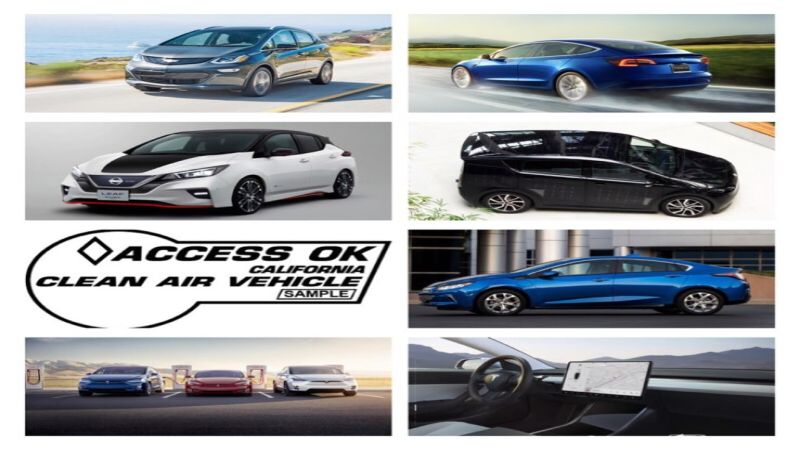




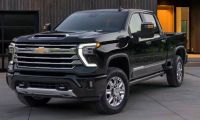
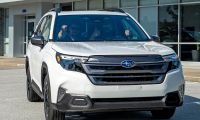
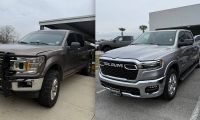
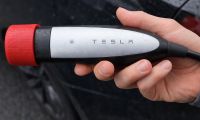
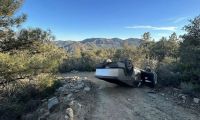
Comments
Completely agree with you on
Permalink
Completely agree with you on the red light cameras. 25% of HOV lanes are single person gas cars. What a difference a year has made. Chevy Volt was killed and Chevron is teaming up with EVgo to put in chargers at some of their stations... progress :)